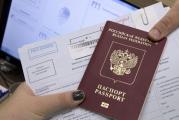What is a Schengen visa and where can I enter with it
Schengen visa - a document that allows you to visit any country from the Schengen area, which includes 26 countries. These are the main European countries, with the exception of the UK. If you have received a visa in any country that is part of the Schengen area, then you can freely move around all countries in this area.
Today the Schengen area includes Austria, Belgium, Hungary, Denmark, Germany, Greece, Iceland, Spain, Italy, Latvia, Lithuania, Liechtenstein, Luxembourg, Malta, Netherlands, Norway, Poland, Portugal, Slovakia, Slovenia, Finland, France, Czech Republic , Sweden, Switzerland and Estonia. De facto, the Schengen area includes three more European microstates - Monaco, San Marino and the Vatican.
In addition, with an open Schengen visa, you can visit Croatia, Albania, Bulgaria, Cyprus, Andorra and the British territory of Gibraltar.

Is it possible to get a Schengen visa at the consulate of one country and go to another
This is a rather subtle point. If you do not yet have a Schengen visa, and you are going to fly, for example, to Italy, then you need to submit documents to the Italian consulate or visa center. This moment is clearly spelled out in the EU Visa Code: for a visa, you must apply to the consulate of the country that is the main purpose of the trip.
That is, you should not, for example, plan a trip to Germany, and get a visa to Greece. The Greeks will have questions, and if, out of the kindness of their hearts, they nevertheless issue you a visa, difficulties will begin in Germany: they may simply not let you into the country at passport control (and sometimes they don’t put you on a plane back in Russia). Remember a simple rule: to avoid problems at the border, get a visa at the consulate of the country you are going to. Got Greek - plan a trip to Rhodes or Athens.
Yes, there are times when border guards are loyal to non-compliance with this rule. Everyone has stories about how someone got a visa to Greece, and then entered Berlin on it and chatted to an officer at the border. But you don't want to hit on someone very principled and end the journey that way, do you?
Important addition! If your passport already contains a Schengen visa left over from a previous trip, then you can use it to enter any country in the Schengen zone. For example, the good Greeks gave you a Schengen for a year, from September 2017 to September 2018. In the fall, you flew to Crete on it, and in the spring you want to see Berlin. In this case, you do not need to get a new Schengen to Germany.

I want to visit several countries, do I need to get a visa for each?
If these are not Schengen countries, then yes, a visa must be obtained in every country (with the exception of countries where Russians are allowed visa-free entry). For example, if you are flying around the world and plan to stop in Germany, the UK, the USA, Mexico and Japan, then you need to obtain a visa for each of the countries listed.
With the countries of the Schengen area, everything is a little simpler: one visa is enough. The question remains, in which country to issue it, and here the EU Visa Code comes to the rescue again: a visa must be issued at the consulate of the country where you plan to stay the longest. Are you going to stay in each country for 2-3 days, that is, for equal time? Then apply for a visa at the consulate of the country you will enter first.
That is, the plan is this: if you are going to Germany, but want to go to neighboring Austria and the Czech Republic for a couple of days, apply for a visa to Germany. If you are planning a trip by car from Moscow to Paris through Latvia, Lithuania, Poland and Germany - and stop everywhere for one or two days, no more - apply for a Schengen visa at the consulate of the country where you cross the border for the first time - that is, Latvia. But if you plan to stay in Paris for a week, you need a French visa.
The main thing is to print out all hotel reservations and tickets before the trip so that the border guards have no questions.

I want a Schengen visa for three years! Where to apply?
Plan your trip to the country that is most willing to issue visas to Russians. In 2017, of the Schengen countries, these are Greece, Spain, Italy, the Czech Republic and France. In these countries, the likelihood that you will be given a Schengen for a year (and under certain conditions for three) is the highest.
What are the conditions? If your passport already contains two or more Schengen visas for the last 3 years, and there are no problems with the documents, then the consulates of these countries will most likely issue you with a multi-visa from 1 to 4 years.
In addition, if your passport already contains an expired visa of the country to which you want to get it again, it is important that the previous visa is correctly opened. This means that, having received a visa to France, you entered France at least once with it. If this condition is met, the chances that you will again be issued a Schengen visa at the French consulate without any problems, but for a longer period, increase.
The least willing to issue Schengen visas are the consulates of Germany, the Netherlands and Portugal - here you are more likely to get a visa only for travel dates. In addition, in the past few years, visa documents have been more carefully checked at the consulates of Finland - the reason for this is the increased flow of tourists from St. Petersburg.

Which visa should be indicated in the application form - single entry or multiple entry?
To begin with, we note that visas differ in the number of visits to countries: they are single, double and multiple (the latter are also called multivisas). Everything is simple here: with a single-entry visa, you can only enter the country once, and if you were given a "cartoon", you can ride to the Schengen countries as many times as you like - until the visa expires, of course.
When filling out the application form, always specify a multiple-entry visa! There are cases when people with a large number of Schengen visas in their passport receive a visa only for travel dates due to the fact that a single entry visa was requested in the questionnaire.

How long can I stay in the Schengen countries if I have a multiple entry visa?
Each visa has a column called Duration of stay - this is the number of days that you can stay in the Schengen countries. Usually in multiple visas it is 90 days, and so much you can stay in the Schengen countries for 6 months. That is, if you were issued a multi-visa for 4 years, then every year you can stay in the Schengen countries for 180 days in total, but not more than 90 days within six months. For example, in six months to go to Italy for a week, then to France for the weekend and spend a couple more weeks in Greece. The main thing is that the total number of travel days for six months does not exceed 90.
The term starts from the beginning of the validity of the visa - the date can be found on the stamp in the "From" column. For example, you received an Italian Schengen visa, which is valid from October 10, 2017 to October 9, 2019. So, the countdown of the first half of the year went on October 10th.
It is important that these 90 days cannot be transferred or summarized every six months. For example, in the first six months of the validity of the visa, you did not go anywhere, but in May you plan to go to Italy for the whole summer and still capture October. Such a trip will turn out to be longer than 90 days, which means that you cannot make it - at the latest in July you will need to return to your homeland. Moreover, having used all 90 days of your stay in Italy, you will not be able to enter other Schengen countries until the end of the six months.




